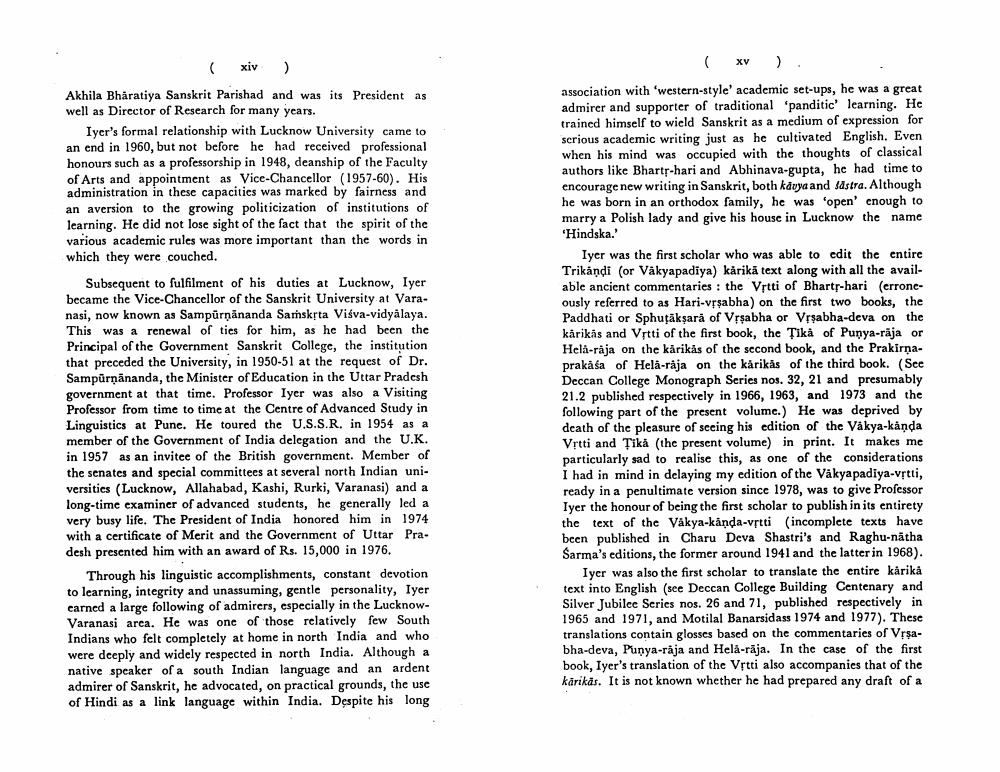Book Title: Foreword Author(s): Ashok Aklujkar Publisher: Ashok Aklujkar View full book textPage 4
________________ ( xiv ) Akhila Bharatiya Sanskrit Parishad and was its President as well as Director of Research for many years. Iyer's formal relationship with Lucknow University came to an end in 1960, but not before he had received professional honours such as a professorship in 1948, deanship of the Faculty of Arts and appointment as Vice-Chancellor (1957-60). His administration in these capacities was marked by fairness and an aversion to the growing politicization of institutions of learning. He did not lose sight of the fact that the spirit of the various academic rules was more important than the words in which they were couched. Subsequent to fulfilment of his duties at Lucknow, Iyer became the Vice-Chancellor of the Sanskrit University at Varanasi, now known as Sampurnananda Sarnsksta Visva-vidyalaya. This was a renewal of ties for him, as he had been the Principal of the Government Sanskrit College, the institution that preceded the University, in 1950-51 at the request of Dr. Sampurnananda, the Minister of Education in the Uttar Pradesh government at that time. Professor Iyer was also a Visiting Professor from time to time at the Centre of Advanced Study in Linguistics at Punc. He toured the U.S.S.R. in 1954 as a member of the Government of India delegation and the U.K. in 1957 as an invitce of the British government. Member of the senates and special committees at several north Indian universities (Lucknow, Allahabad, Kashi, Rurki, Varanasi) and a long-time examiner of advanced students, he generally led a very busy life. The President of India honored him in 1974 with a certificate of Merit and the Government of Uttar Pradesh presented him with an award of Rs. 15,000 in 1976. Through his linguistic accomplishments, constant devotion to learning, integrity and unassuming, gentle personality, Iyer earned a large following of admirers, especially in the LucknowVaranasi arca. He was one of those relatively few South Indians who felt completely at home in north India and who were deeply and widely respected in north India. Although a native speaker of a south Indian language and an ardent admirer of Sanskrit, he advocated, on practical grounds, the use of Hindi as a link language within India. Despite his long association with 'western-style' academic set-ups, he was a great admirer and supporter of traditional 'panditic' learning. He trained himself to wield Sanskrit as a medium of expression for serious academic writing just as he cultivated English. Even when his mind was occupied with the thoughts of classical authors like Bharts-hari and Abhinava-gupta, he had time to encourage new writing in Sanskrit, both kavya and lastra. Although he was born in an orthodox family, he was 'open' enough to marry a Polish lady and give his house in Lucknow the name 'Hindska. Iyer was the first scholar who was able to edit the entire Trikandi (or Väkyapadiya) kårikā text along with all the available ancient commentaries : the Vrtti of Bhartr-hari (erroneously referred to as Hari-vrsabha) on the first two books, the Paddhati or Sphuţāksară of Vrsabha or Vrsabha-deva on the kärikäs and Vrtti of the first book, the Tikå of Punya-raja or Helå-raja on the kårikås of the second book, and the Prakirnaprakāśa of Hela-raja on the karikäs of the third book. (Sce Deccan College Monograph Series nos. 32, 21 and presumably 21.2 published respectively in 1966, 1963, and 1973 and the following part of the present volume.) He was deprived by death of the pleasure of sceing his edition of the Vakya-kanda Vrtti and Tika (the present volume) in print. It makes me particularly sad to realise this, as one of the considerations I had in mind in delaying my edition of the Vakya padiya-vrtti, ready in a penultimate version since 1978, was to give Professor Iyer the honour of being the first scholar to publish in its entirety the text of the Väkya-kanda-vrtti (incomplete texts have been published in Charu Deva Shastri's and Raghu-nătha Sarma's editions, the former around 1941 and the latter in 1968). Iyer was also the first scholar to translate the entire karika text into English (sce Deccan College Building Centenary and Silver Jubilee Scrics nos. 26 and 71, published respectively in 1965 and 1971, and Motilal Banarsidass 1974 and 1977). These translations contain glosses based on the commentaries of Vrsabha-deva, Punya-raja and Helä-raja. In the case of the first book, Iyer's translation of the Vrtti also accompanies that of the kärikäs. It is not known whether he had prepared any draft of aPage Navigation
1 2 3 4 5 6
